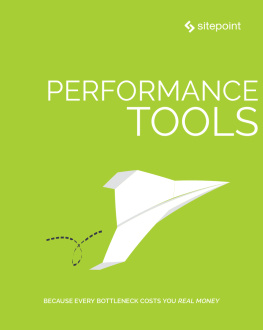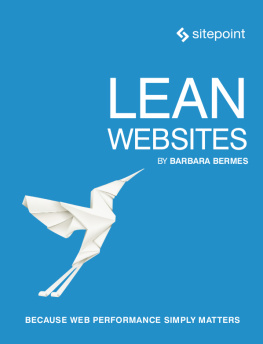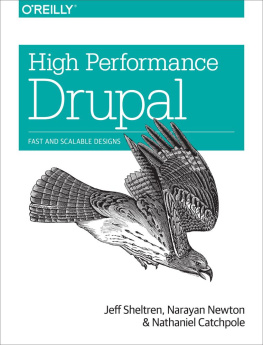CONTENTS
PART I
Front End
- CHAPTER 1: A Refresher on Web Browsers
- CHAPTER 2: Utilizing Client-Side Caching
- CHAPTER 3: Content Compression
- CHAPTER 4: Keeping the Size Down with Minification
- CHAPTER 5: Optimizing Web Graphics and CSS
- CHAPTER 6: JavaScript, the Document Object Model, and Ajax
Chapter 1
A Refresher on Web Browsers
WHATS IN THIS CHAPTER?
- Reviewing web browsers and the HTTP protocol
- Understanding the steps involved in loading a web page
- Getting to know Keep Alive and parallel downloading
To access a website, you need a web browser the piece of client-side software that requests resources from a web server and then displays them. Web browsers are one of the most important pieces of software in the modern Internet, and competition between vendors is fierce so much so that many vendors have chosen to give their browsers away for free, knowing that an increased share of the browser market can indirectly reap profits in other areas.
Although such competition is good news for consumers, it can be a different story for web developers, who must strive to make their sites display correctly in the myriad of browsers, each of which has its own idiosyncrasies and nonstandard behavior. To understand how this situation has evolved, lets begin by returning to the early days of the World Wide Web.
A BRIEF HISTORY OF WEB BROWSERS
Although Mosaic is often thought of as the first web browser to hit the market, this isnt actually true that honor falls on WorldWideWeb, a browser developed by Tim Berners-Lee in 1990 at the same time as he developed the HTTP 0.9 protocol. Other browsers soon followed, including Erwise, ViolaWWW, MidasWWW, and Cello with Cello being, at this point, the only browser for Microsoft Windows. The year 1992 also saw the release of Lynx, the first text-based browser the others all utilized graphical user interfaces (GUIs).
In 1993, Marc Andreessen and Eric Bina created Mosaic. Although Mosaic was not as sophisticated as its competitors, a lot of effort had gone into making it easy to install. And it had one other big advantage. Previous browsers had mostly been student projects, and as such, they often floundered after the students graduated. On the other hand, Mosaic had a team of full-time programmers developing it and offering technical support. Thanks to some clever marketing, Mosaic and the web were starting to become linked in the minds of the public.
In 1994, a dispute over the naming of Mosaic forced a rebranding, and Netscape Navigator was born. Unfortunately, regular changes to the licensing terms meant that, for the next few years, there was ongoing confusion over how free it actually was.
Microsoft entered the market in 1995 with Internet Explorer (IE) 1.0, which was also based on Mosaic, from whom Microsoft had licensed the code. IE 2.0 followed later that year, with IE 3.0 following in 1996. IE 3.0 was notable for introducing support for cascading style sheets (CSS), Java, and ActiveX, but Netscape continued to dominate the market, with IE making up only approximately 10 percent of the market.
Netscape Loses Its Dominance
Over the following years, the market swiftly turned in Microsofts favor. By IE 4.0 (released in 1997), Microsofts share of the market had increased to 20 percent, and, by the release of IE 5 in 1999, this had risen to 50 percent. Microsofts dominance peaked in the first few years of the twenty-first century, with IE 6.0 (released in 2001) claiming more than 80 percent of the market.
Microsofts aggressive marketing included a decision to bundle IE with Windows. But theres no denying that, at this point in the late 1990s, IE was simply the better browser. Netscape was prone to crashing, it was not as fast as IE, and it was beginning to look distinctly old-fashioned.
In an attempt to revive its fortunes, Netscape decided to release the source code for Navigator, and branded it as Mozilla (also known as Netscape 5), entrusting it to the newly formed Mozilla Foundation. Although this was an important turning point in the history of the web, it did little to help in the immediate future. AOL purchased Netscape, and released Netscape 6 in 2000 and Netscape 7 in 2002. This failed to halt the downturn, though, and AOL eventually announced the end of Netscape in 2008, a year after the release of both Netscape 8 and 9 (which, ironically, were now based on Firefox).
The Growth of Firefox
By 2000, it was clear that Microsoft had won the browser wars, and for the next few years, it enjoyed unchallenged dominance of the market. However, the Mozilla Foundation was still hard at work. Mozilla 1.0 was released in 2002 but failed to make much of an impact in the Windows environment.
Some Mozilla developers were becoming increasingly unhappy with the direction Mozilla was taking, feeling it was becoming increasingly bloated, and branched off their own port of the Mozilla code. After several changes to the name, this ultimately became Mozilla Firefox usually referred to simply as Firefox.
Firefox 1.0 was released in 2004, but it wasnt until version 2.0, released 2 years later that things began to take off. Mozilla marketed Firefox heavily to the everyday user as a faster, more secure alternative to IE; while bloggers and techies were quick to praise the more advanced features. Finally, it was felt, there was a worthy rival to IE, and by the end of 2006, Firefoxs share of the market had risen to 10 percent.
Firefox 3.0 was released in 2008, and by the end of 2010, had a market share of approximately 25 to 30 percent. Its ironic that just as IEs early growth was boosted by dissatisfaction among Netscape users, Firefoxs growth was aided enormously by growing dissatisfaction among IE users. Indeed, it was felt that, having won the browser war, Microsoft had become somewhat complacent, with IE 6 and 7 being somewhat insipid.
The Present
Microsoft managed to get back on track with the release of IE 8 in 2008. As well as being compliant with CSS 2.1 and Acid 2, IE 8 finally included tabbed browsing a feature that had been present in Opera and Firefox for some time.
In 2011, IE 9 was released, boasting CSS 3 support; improved graphics rendering; and a new JavaScript engine, Chakra, which was capable of better utilizing multicore CPUs. Also in 2011, Firefox 4 was released with its own new JavaScript engine (JagerMonkey) and hardware graphics accelerator.
INSIDE HTTP
Before beginning an examination of optimization techniques, it would be beneficial to understand how the web works. The remainder of this chapter recaps the basics of the HyperText Transfer Protocol (HTTP), discusses the differences between HTTP 1.0 and 1.1 (in particular, those relating to performance), and then follows the steps taken when a browser requests a page from the initial domain name service (DNS) look-up through to the rendering. Later chapters revisit these steps in more detail, and you will learn ways to improve performance.
The HyperText Transfer Protocol
HTTP is the means by which web browsers (clients) communicate with web servers and vice versa. Its a text-based protocol operating at the application layer, and, as such, HTTP doesnt concern itself with issues such as routing or error checking: This is the job of the lower layers such as transmission control protocol (TCP) and Internet Protocol (IP).
THE OSI MODEL
The Open Systems Interconnection (OSI) model is a commonly used means of representing the various parts of network traffic in terms of layers, reflecting the way in which encapsulation of data works. The OSI model defines seven layers (the older TCP/IP model defines just four). The seven layers include the following:

















